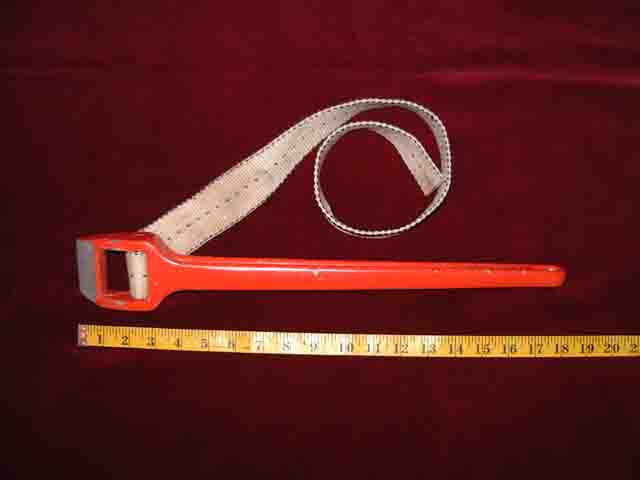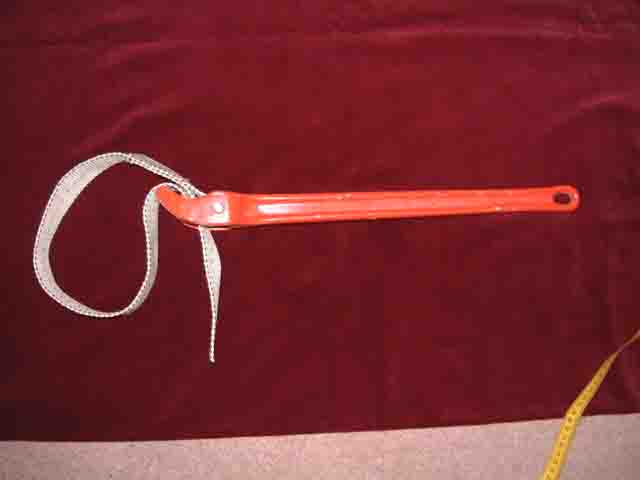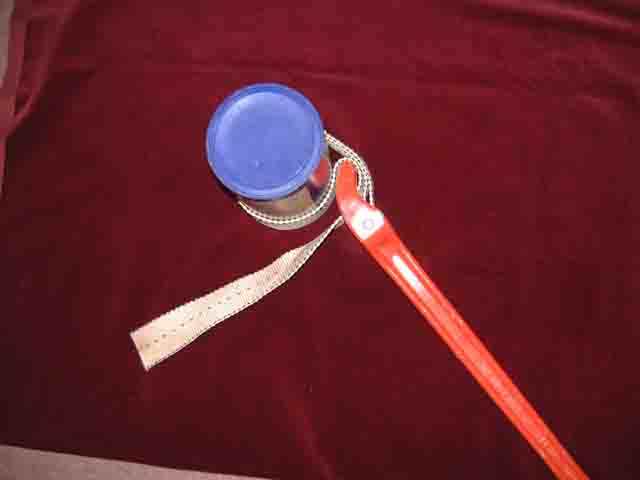| Author | Message | ||||
Barry Brears Frequent User Username: turney_2009 Post Number: 53 Registered: 8-2009 |
Hi,Can anyone help me I need to replace the push rod in the rear brake pump how do I go about this task after removing the outer casing of the pump. Barry | ||||
Chris Browne Experienced User Username: chrisb Post Number: 25 Registered: 2-2010 |
Hi Barry. If you are going to replace a broken push rod, this is a big job, I think. You cannot fit the pushrod from above. You will have to remove the carburettors and inlet manifold and then remove the tappet chest cover exposing the tappets and pushrods. The pump base will have to be removed from the underside of the cover before you can replace the pushrod. On reassembly, the pumps have to be shimmed to strict tolerances to enable them to work correctly. If you haven't got a manual, I would have a look at the on-line manual in the RROCA library so you can see what is involved. Sorry to be the bearer of bad news.  Kind regards, Chris (Message edited by david_gore on 24 September 2010) | ||||
Bill Coburn Moderator Username: bill_coburn Post Number: 1279 Registered: 4-2003 |
Have either of you heard of Tee One Topics? It's been going for the best part of 10 years and is on 5 web sights around the world including our own Technical Library. Have a look at issue 77. Don't be daunted Barry,it is not bad news. These rods are well beyond their use-by-date. The subject in fact has been addressed quite recently in these very columns. In short, I take the bonnet off, drain the coolant, draw a map or take lots of pics of all the pipes etc on the top of the engine, remove the induction assembly (one bolt)unscrew the pumps (you should do both) remove the intake manifold and then the valley cover and there they are. If you do not have a pump spanner don't borrow Richard Treacy's he hasn't got it back yet from the last nice man who borrowed it! The inlet manifold will come off with the pumps on albeit with the covers off and you can undo them with a 'C' spanner or if you prefer a cold chisel and brickee's hammer!!!!!!!! (It has been done!!) The manual and Topics will tell you the rest. You will need to rough up a bracket to hold a dial gauge to ascertain TDC of the pump cam and a depth micrometer to check the protrusion. R A Chapman in Melbourne can supply all the consumables including new push rods and then put the whole thing back together. Best you also give the pumps a good clean out and fit new 'O' rings. That is also detailed in Topics. | ||||
David Gore Moderator Username: david_gore Post Number: 980 Registered: 4-2003 |
Barry, You will need a depth gauge and some shims to adjust the pushrod clearance - most important to get this right to minimise pump "clatter". Just go to an engineer's supply store such as Blackwoods and buy a set of brass shim stock [these include a range of thicknesses] to cut the necessary shims to size. Otherwise, you can buy these from Crewe Spares but you will need a full range of thicknesses as you will not know how many shims you need until you replace the cover and pump without shims and measure the depth to calculate the thickness of shims required. Murphy's Law applies here - the shims you take out will not be all that you will need for the replacement pushrod. (Message edited by david_gore on 24 September 2010) | ||||
Richard Treacy Grand Master Username: richard_treacy Post Number: 2217 Registered: 4-2003 |
I bought a shim steel pack at ABC Bearings. It has about four thicknesses .001" to 0.010", sheets approximately 15cmx15cm. It's always useful to have those in the toolshed. While you are at it, why not replace the valve stem seals with proper ones to zero the oil consumption, and reseal the rocker covers ? It's a relatively short extension to the job. By the way, a digital calliper from your bearing shop for $49.99 gives a more than accurate depth gauge to reset the pumps. RT. | ||||
Barry Brears Frequent User Username: turney_2009 Post Number: 54 Registered: 8-2009 |
Thanks Gentlemen for your information Bill I have heard of TEE ONE TOPICS and I did have a look but the search tool is not helpful and to go through every topice would take a month of sundays.I have ordered the parts already and they are on the way,again thanks for your help. Regards Barry | ||||
Richard Treacy Grand Master Username: richard_treacy Post Number: 2218 Registered: 4-2003 |
ps: Barry, Before you dive into a pushrod job: The pump pushrods are binary things: they are either working perfectly or snapped at the special shear point. They cannot bend without snapping first. Doing a pushrod job could end in frustration if the pumps are working but noisy. First, put your gonads in ESCROW at the bank and borrow a pressure gauge if you can. Check that the pumps are cycling in and out as described in the book. The pressure should slowly drop to 1800-2000psi until the valve body kicks the pump in, then then rise to 2200-2500psi. The cycle repeats itself continuously. If the valves are malfunctioning, then you will see something else and the pump will sound like a worn-out Routemaster. Likewise, if a sphere is flat or has a ruptured diaphragm, then the pump may be noisy. Either will show up straight away with a pressure test. If the valve body, which hold the accumulator sphere on an SY, is in need of attention, then it is a relatively inexpensive and straightforward repair. Incidentally, if you do attend to the pushrods, best take the valley cover complete with pumps to a workshop and use their C-Spanners to remove the pumps. They may be refitted on the car successfully using a simple strap wrench once the correct shims have been chosen. RT. | ||||
Barry Brears Frequent User Username: turney_2009 Post Number: 55 Registered: 8-2009 |
Thanks Richard Now I'm going to ask THAT question "please explain"what is escro,what is gonads,what is a strap wrench and where and how do I check the pressures.Sorry I'm so dim. Barry | ||||
Barry Brears Frequent User Username: turney_2009 Post Number: 56 Registered: 8-2009 |
Right have worked out everything except how to check the pressures. Barry | ||||
Paul Yorke Grand Master Username: paul_yorke Post Number: 664 Registered: 6-2006 |
Barry, To check the pressures you need a gauge with at least 3000 PSI scale and a hose to screw it into the easiest point on the HP side of the accumulator. ( steel flexi or a calliper type hose ) if you do want to check the pump pushrods you can do it quickly and easily if you can buy or hire the pump removal tool. Either the tube type or a C spanner on a 12" 90 degree extension (I'll try and post a picture). You can then either check the height your rods are standing at or drop a couple of new rods in and try them for size first - you have nothing to lose but a good days work to gain. After all, you wouldn't whip a head off to check the spark plug gaps.  Do strip and clean the pump completely - kits are available. Check the spring at the bottom of the pump to, they do loose tension and can snap to. (less than £15) The small one way valve at the top can gum up to. | ||||
Peter Talbot Experienced User Username: squerryes Post Number: 50 Registered: 7-2010 |
Barry Richard does like a wind-up!! Putting your gonads in Escrow might (a)be painful and (b) adversely affect your marital relationship. Joking apart, a strap wrench is just exactly what the name implies - I'll go and photograph one and post the images a bit later on. Peter | ||||
Richard Treacy Grand Master Username: richard_treacy Post Number: 2221 Registered: 4-2003 |
I hope that Peter can post a picture of a strap wrence. Essentially, an oil filter remover for a Holden is a strap wrench. The pressure test is shown in the Technical Library under Accumulator Accumulators: To Test http://rrtechnical.info/SY/TSD4200/g/sections/g7.pdf or open the extracts in the attachments:
It is self explanatory. A transmission shop (or a farm machinery shop at Nelligen) may have a suitable gauge, and you may need an adaptor for the thread. Essentially, attach the gauge to the suspect system, run the motor and watch for the needle to cycle. Maybe a $100 surety with the gauge's owner would be a less painful deposit than my earlier suggestion. RT. PS: If anyone needs O-Rings for the RR363 pumps and spheres, please let me know as I have this morning received a few dozen spares - note that the correct material is extremely important. The same applies if anyone needs O-Ring kits for the pumps on mineral oil cars - do let me know. Again, I have a few dozen. They are for my own use, but would be happy to share them. Note that the pump housing O-Rings for RR363 and LHM pumps are physically identical, but are made from completely different materials. One fitted either way in the wrong system will fail in a month or so. | ||||
Richard Treacy Grand Master Username: richard_treacy Post Number: 2223 Registered: 4-2003 |
Here is a picture of a typical strap wrench. You will find a catalogue of typical strap wrenches in the attachment.
 | ||||
Peter Talbot Frequent User Username: squerryes Post Number: 51 Registered: 7-2010 |
I'm trying !! The 640 x 480 image size limit is causing me real probs in degrading my image files to suit. Watch this space. Peter | ||||
Peter Talbot Frequent User Username: squerryes Post Number: 52 Registered: 7-2010 |
Ye Gods and Little Fishes !! I've degraded Images to suit the 640x480 limit - here's Image 1 Peter  | ||||
Peter Talbot Frequent User Username: squerryes Post Number: 53 Registered: 7-2010 |
Image 2 - Peter  | ||||
Peter Talbot Frequent User Username: squerryes Post Number: 54 Registered: 7-2010 |
Image 3 - Peter  | ||||
Peter Talbot Frequent User Username: squerryes Post Number: 55 Registered: 7-2010 |
Hey!! - I did it !! Image 1: an 18" strap wrench Image 2: shows how to thread strap Image 3: strap wrench in use - as you pull back handle in clockwise direction, the strap is caught and tightens round object. Note: (a) Just reverse the strap wrench for anti-clockwise requirements. (b) Strap wrenches come in all sorts of sizes - the wrench pictured has an 18" handle. The torque available, only with modest effort, is high. The message is: take it very, but very, gently. Peter | ||||
Richard Treacy Grand Master Username: richard_treacy Post Number: 2225 Registered: 4-2003 |
Thanks, Peter. As for size to suit a brake pump, one like the Reed SW12A Strap Wrench designed for 1/8" to 2" tubes seems to be ideal. The pump body which needs gripping is about ��.  These things cost about $40 for a top-quality brand like a Rigid, a Rothenberger or a Reed, or $5 for a cheapo. Reece Plumbing, located all over Australia, sells Rothenberger and Reed strap wrenches. The one shown would be plenty strong enough to install a brake pump, and with the valley on a bench there would ne no clearance issues. It may even squeeze in in-situ. I wonder how much torque it will handle when undoing a tight pump? Of course, important about strap wrenchs is that they grip a polished metal surface and do no damage. A chain wrench is much stronger, but even with a brass shim wrapped around to protect the pump, the surface is at risk. Also, gripping the surface is more tricky with a chain wrench than with a strap wrench. RT. | ||||
Peter Talbot Frequent User Username: squerryes Post Number: 56 Registered: 7-2010 |
Add-on to post above by Richard. Just forget about even thinking of using a chain wrench - a real good tool but not appropriate. Yes, strap wrenches grip a polished surface without damage but: (a) it's first best to clean off any grease/oil from the item to be removed, as otherwise the strap will be contaminated and not grip as well next time you want to use it. (b) Strap quality is variable - at the "cheapo" end of the market straps are often comprised of really coarse/harsh synthetic fibres. Yes, they grip well but if you haven't got the strap properly tightened fully before applying torque then the strap will slide round and may cause scratches to the housing being removed. Peter | ||||
Barry Brears Frequent User Username: turney_2009 Post Number: 58 Registered: 8-2009 |
Thankyou gentlemen for your kind attention etc etc all this info is very helpful. Barry |